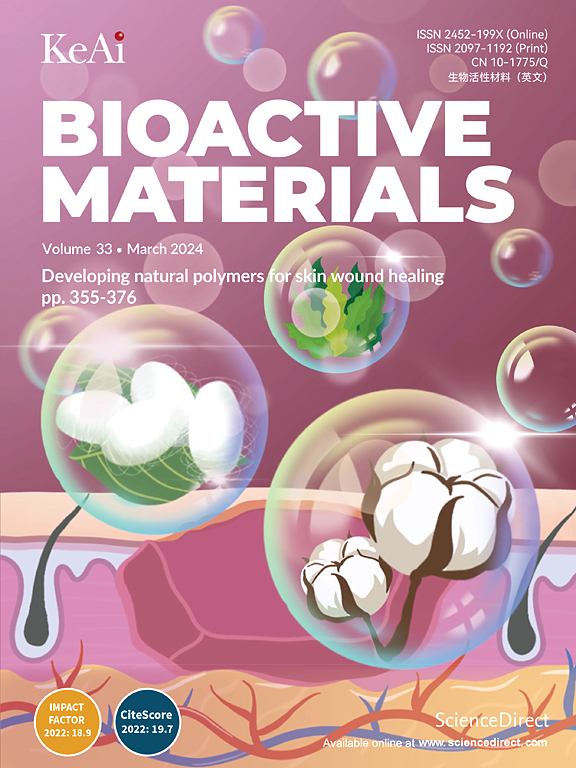Nanotherapeutic strategies exploiting biological traits of cancer stem cells
IF 18
1区 医学
Q1 ENGINEERING, BIOMEDICAL
引用次数: 0
Abstract
Cancer stem cells (CSCs) represent a distinct subpopulation of cancer cells that orchestrate cancer initiation, progression, metastasis, and therapeutic resistance. Despite advances in conventional therapies, the persistence of CSCs remains a major obstacle to achieving cancer eradication. Nanomedicine-based approaches have emerged for precise CSC targeting and elimination, offering unique advantages in overcoming the limitations of traditional treatments. This review systematically analyzes recent developments in nanomedicine for CSC-targeted therapy, emphasizing innovative nanomaterial designs addressing CSC-specific challenges. We first provide a detailed examination of CSC biology, focusing on their surface markers, signaling networks, microenvironmental interactions, and metabolic signatures. On this basis, we critically evaluate cutting-edge nanomaterial engineering designed to exploit these CSC traits, including stimuli-responsive nanodrugs, nanocarriers for drug delivery, and multifunctional nanoplatforms capable of generating localized hyperthermia or reactive oxygen species. These sophisticated nanotherapeutic approaches enhance selectivity and efficacy in CSC elimination, potentially circumventing drug resistance and cancer recurrence. Finally, we present an in-depth analysis of current challenges in translating nanomedicine-based CSC-targeted therapies from bench to bedside, offering critical insights into future research directions and clinical implementation. This review aims to provide a comprehensive framework for understanding the intersection of nanomedicine and CSC biology, contributing to more effective cancer treatment modalities.

利用肿瘤干细胞生物学特性的纳米治疗策略
癌症干细胞(CSCs)代表了一个独特的癌细胞亚群,它协调了癌症的发生、进展、转移和治疗耐药性。尽管传统疗法取得了进步,但csc的持续存在仍然是实现根除癌症的主要障碍。基于纳米医学的方法已经出现,用于精确靶向和消除CSC,在克服传统治疗的局限性方面提供了独特的优势。本文系统分析了纳米医学用于csc靶向治疗的最新进展,强调了解决csc特异性挑战的创新纳米材料设计。我们首先提供了CSC生物学的详细检查,重点关注它们的表面标记,信号网络,微环境相互作用和代谢特征。在此基础上,我们批判性地评估了旨在利用这些CSC特性的尖端纳米材料工程,包括刺激反应纳米药物,用于药物递送的纳米载体,以及能够产生局部热疗或活性氧的多功能纳米平台。这些复杂的纳米治疗方法提高了CSC消除的选择性和有效性,潜在地避免了耐药性和癌症复发。最后,我们深入分析了目前基于纳米医学的csc靶向治疗从实验室到床边的挑战,为未来的研究方向和临床实施提供了重要的见解。本文旨在为理解纳米医学与CSC生物学的交叉提供一个全面的框架,为更有效的癌症治疗方式做出贡献。
本文章由计算机程序翻译,如有差异,请以英文原文为准。
求助全文
约1分钟内获得全文
求助全文
来源期刊

Bioactive Materials
Biochemistry, Genetics and Molecular Biology-Biotechnology
CiteScore
28.00
自引率
6.30%
发文量
436
审稿时长
20 days
期刊介绍:
Bioactive Materials is a peer-reviewed research publication that focuses on advancements in bioactive materials. The journal accepts research papers, reviews, and rapid communications in the field of next-generation biomaterials that interact with cells, tissues, and organs in various living organisms.
The primary goal of Bioactive Materials is to promote the science and engineering of biomaterials that exhibit adaptiveness to the biological environment. These materials are specifically designed to stimulate or direct appropriate cell and tissue responses or regulate interactions with microorganisms.
The journal covers a wide range of bioactive materials, including those that are engineered or designed in terms of their physical form (e.g. particulate, fiber), topology (e.g. porosity, surface roughness), or dimensions (ranging from macro to nano-scales). Contributions are sought from the following categories of bioactive materials:
Bioactive metals and alloys
Bioactive inorganics: ceramics, glasses, and carbon-based materials
Bioactive polymers and gels
Bioactive materials derived from natural sources
Bioactive composites
These materials find applications in human and veterinary medicine, such as implants, tissue engineering scaffolds, cell/drug/gene carriers, as well as imaging and sensing devices.
 求助内容:
求助内容: 应助结果提醒方式:
应助结果提醒方式:


